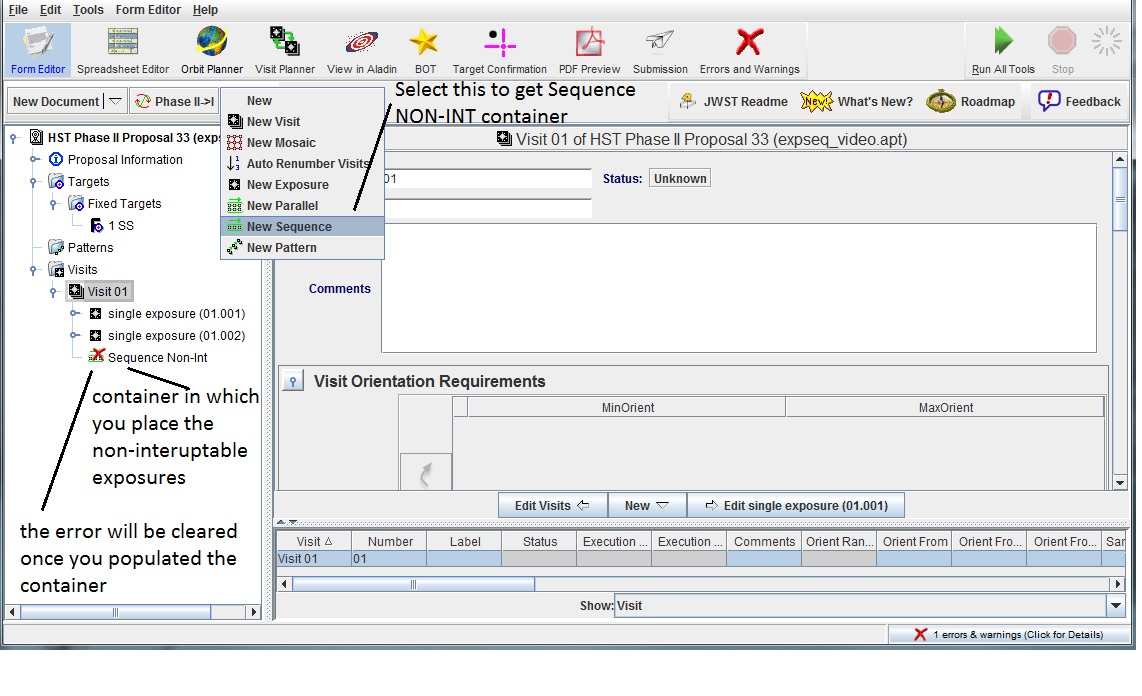CREATING NON-INTERRUPTIBLE EXPOSURE SEQUENCES
Overview
This document describes how to create a non-interruptible
exposure sequence; see the
training movie.
To create exposure sequences in APT, you create a
 Sequence Non-Int container that holds
these related exposures (in the same way there is a
Sequence Non-Int container that holds
these related exposures (in the same way there is a
 Visit container
holding all exposures in a visit). For exposure sequences, this
container holds the exposures that, for scientific reasons, need to
occur without the interruption of an occultation or SAA passage. Note
that when using the Text file for your proposal, you need to use the
SEQ NON-INT special requirement to tie the exposures together.
Visit container
holding all exposures in a visit). For exposure sequences, this
container holds the exposures that, for scientific reasons, need to
occur without the interruption of an occultation or SAA passage. Note
that when using the Text file for your proposal, you need to use the
SEQ NON-INT special requirement to tie the exposures together.
Creating the Exposure Sequence Container
To create the
 Sequence Non-Int container, you need to have the correct
context set in the tree editor. Select either the
Sequence Non-Int container, you need to have the correct
context set in the tree editor. Select either the
 Visit container
or an
Visit container
or an
 exposure in the visit. Under the New button,
select
exposure in the visit. Under the New button,
select
 New Sequence to get the container.
New Sequence to get the container.

Populating the container
With the container created, either copy/drag an existing exposure into
it, or create a new exposure (with the context set to the container,
select the New Exposure option). The container will now have a key on
the left, which you can open to show the exposure inside. Also note
that the title of the container now has the exposure number of what it
contains appended to it. The sequenced exposures can now be
added to the container.
Creating and Populating the container in 1 step
If you have already defined the exposures you want in the Seqence
Non-Int container, you can select the exposure in the APT Tree
Editor, go to the Edit Menu, and select Group/New Sequence. This
will place the exposures in a Sequence Non-Int container.

Looking at the results
With the visit(s) specified, run the
 Orbit Planner to examine the
results. See the Orbit Planner help
and movie for more information.
Orbit Planner to examine the
results. See the Orbit Planner help
and movie for more information.

The  Orbit Planner output shows that all exposures in the group
do occur in one orbit, without any interruptions. The reason orbit
1 is not packed is that the
Orbit Planner output shows that all exposures in the group
do occur in one orbit, without any interruptions. The reason orbit
1 is not packed is that the
 Sequence Non-Int Group cannot be interrupted
by an occultation, and since both exposures did not fit, orbit
1 was left unfilled.
Sequence Non-Int Group cannot be interrupted
by an occultation, and since both exposures did not fit, orbit
1 was left unfilled.
Last modified: May 9, 2014.


 Orbit Planner to examine the
results. See the Orbit Planner help
and movie for more information.
Orbit Planner to examine the
results. See the Orbit Planner help
and movie for more information.

 Orbit Planner output shows that all exposures in the group
do occur in one orbit, without any interruptions. The reason orbit
1 is not packed is that the
Orbit Planner output shows that all exposures in the group
do occur in one orbit, without any interruptions. The reason orbit
1 is not packed is that the